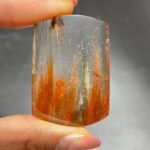Crystals, with their captivating beauty and intriguing properties, have captivated human hearts for centuries. Delving into the world of crystal identification empowers you to harness their unique energies and reap their potential benefits. This guide will equip you with the knowledge and techniques to identify crystals accurately, unlocking a realm of possibilities.

Visual Examination: The Cornerstone of Identification
Visual examination is the primary method for identifying crystals. It involves observing their physical characteristics, including:
Crystal Shape: Crystals exhibit specific geometric shapes based on their internal atomic structure. Common shapes include cubic, octahedral, hexagonal, and pyramidal.
Luster: The way a crystal reflects light is known as its luster. It can range from metallic to vitreous (glassy) to pearly.
Color: The color of a crystal arises from the presence of impurities or defects in its structure. It can vary widely, with some crystals being transparent, while others are opaque or translucent.
Cleavage and Fracture: Clues to Internal Structure
When subjected to force, crystals may exhibit cleavage or fracture. Cleavage refers to the tendency of a crystal to break along specific planes of weakness, resulting in smooth, flat surfaces. Fracture, on the other hand, occurs when a crystal breaks irregularly without any preferred direction.
Hardness: The hardness of a crystal measures its resistance to scratching. It is determined using the Mohs scale, which ranks minerals from 1 (softest, e.g., talc) to 10 (hardest, e.g., diamond).
Crystal System: The crystal system describes the overall symmetry of a crystal’s external form. There are seven crystal systems: cubic, tetragonal, orthorhombic, monoclinic, triclinic, hexagonal, and trigonal.
Advanced Techniques for Precise Identification
While visual examination is often sufficient for basic identification, more advanced techniques may be necessary for accurate determination.
Refractive Index: The refractive index measures how much light bends when passing through a crystal. It can help distinguish between similar-looking crystals.
X-ray Crystallography: This technique involves using X-rays to determine the arrangement of atoms within a crystal, providing precise identification.
Infrared Spectroscopy: This method analyzes the absorption and emission of infrared radiation by a crystal, revealing its chemical composition.
Table 1: Common Crystal Shapes and Their Respective Mineral Classes
| Shape | Mineral Class | Example |
|---|---|---|
| Cubic | Isometric | Pyrite, Fluorite |
| Octahedral | Isometric | Garnet, Diamond |
| Hexagonal | Hexagonal | Quartz, Calcite |
| Pyramidal | Tetragonal | Zircon, Topaz |
| Prismatic | Orthorhombic | Gypsum, Celestite |
Table 2: Luster Classification and Examples
| Luster | Description | Example |
|---|---|---|
| Metallic | Shiny like metal | Gold, Pyrite |
| Vitreous | Glassy | Quartz, Calcite |
| Pearly | Resembling mother-of-pearl | Moonstone, Pearl |
| Resinous | Like pine resin | Sphalerite, Garnet |
| Dull | No shine | Kaolinite, Chalk |
Table 3: Mohs Hardness Scale and Examples
| Hardness | Description | Example |
|---|---|---|
| 1 | Can be scratched by a fingernail | Talc |
| 5 | Can be scratched by a knife | Apatite |
| 7 | Can scratch glass | Quartz |
| 10 | Cannot be scratched | Diamond |
Table 4: Crystal Systems and Examples
| Crystal System | Symmetry | Example |
|---|---|---|
| Cubic | All axes are equal and perpendicular | Diamond, Fluorite |
| Tetragonal | Two axes are equal and perpendicular to the third | Zircon, Rutile |
| Orthorhombic | Three axes are all perpendicular to each other | Topaz, Gypsum |
| Monoclinic | Three axes, two of which are perpendicular to the third | Muscovite, Orthoclase |
| Triclinic | Three axes, none of which are perpendicular to each other | Albite, Anorthite |
| Hexagonal | Six-sided prism | Quartz, Calcite |
| Trigonal | Three-sided prism | Tourmaline, Hematite |
Crystal Identification Beyond Traditional Methods: Exploring New Applications
The field of crystal identification is constantly evolving, with emerging technologies and innovative applications. One exciting area of research focuses on the use of artificial intelligence (AI) to automate the process. AI algorithms can analyze large datasets of crystal images, identifying patterns and variations that enable accurate and efficient classification. This has the potential to accelerate research and development in fields such as geology, mineralogy, and materials science.
Conclusion: Unlocking the Power of Crystal Identification
Identifying crystals is a rewarding pursuit that opens doors to endless possibilities. Whether you’re a collector, a healer, or simply someone fascinated by the beauty of nature’s wonders, this guide has provided you with the tools and knowledge to confidently embark on this journey. Embrace the allure of crystals, discover their unique properties, and unlock the transformative power they hold.




























